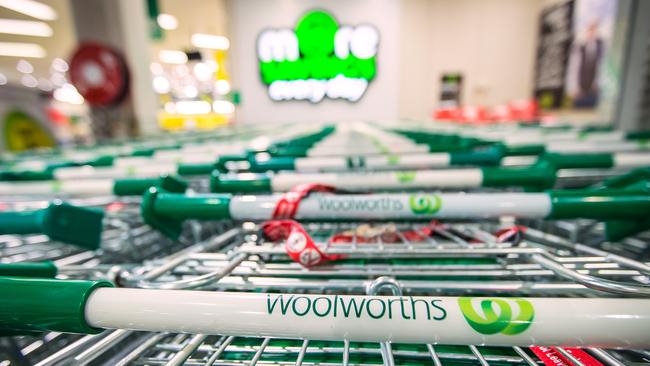Woolworths swings back to profit in first half
WOOLWORTHS has beat expectations with a strong first-half result, in a sign the supermarket giant’s billion-dollar investment in prices has paid off.

WOOLWORTHS has beat market expectations with a strong first-half result, in a sign the supermarket giant’s billion-dollar investment in lowering prices has paid off.
The company has swung back to a half-year profit of $725.3 million despite a 13.9 per cent decline in underlying earnings from its Australian food division.
This time last year, the retailer unveiled a loss of $972.7 million — its first in 23 years — after taking a $3.25 billion hit from the failed Masters business.
As widely expected, Woolworths snapped a seven-and-a-half year losing streak, beating Coles in quarterly sales growth for the first time since 2009.
Woolworths’ comparable food sales figure, which strips out one off events, rose 3.1 per cent in the second quarter, compared with Coles which posted growth of 0.9 per cent.
Average prices declined by 2.6 per cent in the second quarter compared with the prior corresponding period, and Woolworths said all major categories except meat and tobacco were in deflation in the first half.
“Customer price perception is beginning to improve but still presents a major opportunity and reflects our efforts to improve customers’ trust in our prices through lowering shelf prices,” the company said.
Woolworths said the decline in underlying food earnings to $811.6 million — down from $942.6 million in the prior corresponding period — was mainly due to the reinstatement of team incentive payments, team training, store renewal and IT investments.
Last week, Coles reported its earnings decreased by 2.6 per cent to $920 million in the six months to December.
“We’ve made good progress on our five key group priorities during the half,” Woolworths chief executive Brad Banducci said. “Particularly pleasing was the improvement in sales momentum in Australian Food, especially in the second quarter.
“This is on the back of strong Voice of Customer (VOC) scores and is underpinned by continued growth in customer transactions and, more recently, items per basket. This momentum gives us confidence that, while we still have a lot to do, we are on the right track.”
Mr Banducci said availability of staff to help customers still needed to improve and more work was needed on the range of groceries and food.
“We are very focused on never finding ourselves in the situation again where we are so far out on price,” he said. “We need to keep vigilant on price and improve communication of price but we have a lot of work to do with the in-store experience.”
UBS analysts described it as a “strong result, ahead of expectations”, saying the turnaround plan “looks to be in full swing”. The investment bank said focus would be on Woolworths’ comments on competitive pressures as price deflation accelerated in the second quarter, from 2.1 per cent to 2.6 per cent.
“[But it] would appear Woolworths is managing these well and outperformance in Food should continue,” UBS wrote.
Elsewhere, the troubled department store chain Big W reported a loss of $27.2 million, with earnings plummeting 88.9 per cent to $8.1 million off a comparable sales decline of 6.3 per cent during the half.
The result was driven by a non-cash charge of $35.3 million, reflecting asset impairment and an increase in the retailer’s onerous lease provision. “We are currently reviewing the Big W strategic plan and this will be completed in the next few months,” Mr Banducci said.
Speaking to analysts, he again rejected suggestions that the group should sell it. “We tried to do too much too quickly [at BIG W] which is hard to execute and you end up dropping the ball,” he said.
“We have to validate what we believe is still a very good business, we need to prove it, and our current numbers don’t. Unless we can deliver and demonstrate, it’s very hard to engage with third parties. The business isn’t bankable on the current numbers and we need to work very hard to change that.”
— with AAP




